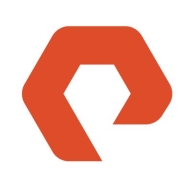

![SwiftStack [EOL] Logo](https://images.peerspot.com/image/upload/c_scale,dpr_3.0,f_auto,q_100,w_64/rCrJ5QMmvucDdhnMyyNUFbAd.jpeg)
Find out what your peers are saying about MinIO, Red Hat, Dell Technologies and others in File and Object Storage.


FlashBlade is the industry’s most advanced scale-out storage for unstructured data, powered by a modern, massively parallel architecture to consolidate complex data silos (like backup appliances and data lakes) and accelerate tomorrow’s discoveries and insights.
Store and manage unstructured data at scale using NetApp StorageGRID for secure, durable object storage. Place content in the right location, at the right time, and on the right storage tier, optimizing workflows and reducing overall costs for globally distributed rich media.
SwiftStack focuses on handling large-scale unstructured data, providing software-defined storage, and boosting data scalability and durability.
SwiftStack is known for its proficiency in object storage, seamless workflow integration, and robust support for multi-cloud environments. Its architecture ensures high-performance data access, making it ideal for big data analytics, media asset management, and backup tasks. Users value its flexibility, ease of integration, and strong performance. The solution's high availability and efficient storage capabilities contribute to its strengths. However, areas needing improvement include customer support response time, initial setup guidance, and enhanced scalability during high-demand periods.
What are SwiftStack's Most Important Features?
What Benefits Should Users Look For?
In industries like media management and big data analytics, SwiftStack’s capabilities in high-performance data access and multi-cloud support facilitate efficient data handling. Backup and archival solutions also benefit from its robust storage and high availability features.
We monitor all File and Object Storage reviews to prevent fraudulent reviews and keep review quality high. We do not post reviews by company employees or direct competitors. We validate each review for authenticity via cross-reference with LinkedIn, and personal follow-up with the reviewer when necessary.